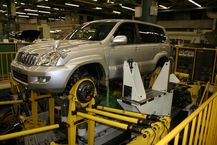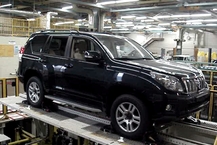Vehicle Performance and Testing
Four-axis Bench Tester and Modification into Six-axis Type
By shifting bad-road driving durability testing to a bench tester and continuously running the tester 24 hours a day, Toyota was able to complete vehicle evaluation in two to three weeks, instead of the three months normally required using road testing, in addition to improving accuracy and dramatically increasing efficiency.
Before installing a tester, products from several companies were comprehensively evaluated and many discussions were held with the then- current Instrument Department of the Quality Division. In the end, Toyota selected a system made by MTS Systems Corporation, which is renowned for large-scale durability testers.
Initially, a single system was installed, but there are now three running. Most of the processes have been digitized thanks to advances in peripheral devices such as personal computers, and the control system has also been reduced in size. The main system has also advanced to six-axis control, and a test method that simulates transportation using freight cars has also been developed as a new application.
-

Multi-axis bench durability tester
-

Testing of durability during freight transport using a multi-axis bench tester
Vehicle Engineering Division Newly Established and Later Significantly Reorganized
As part of the final step in restructuring the FP organization (and building the Center System), R&D groups were reorganized and strengthened, newly establishing Vehicle Engineering Division, which would consist of three departments and one section with advanced development as its mission. Development Department No. 1 gathered primarily design engineers while Development Department No. 2 gathered testing engineers. Most of these engineers were transferred from the former Higashifuji Development 11 and several engineers were also transferred from the Engineering Department of the Vehicle Evaluation & Engineering Division at the Head Office.
Two years after its establishment, Vehicle Engineering Division was reorganized into Groups 1K through 7K. The Functional Project General Manager of each group is the overall manager for each vehicle performance class and is also a world-class engineer. Their roles are defined as follows:
- - Development and promotion of advanced development scenarios
- - Involvement with product development
- - Auditing of the target performance and performance forecast of Vehicle Evaluation & Engineering Division and vehicle-level check
- -Holding and promotion of liaison meetings for each vehicle performance class
- - Establishment of advanced development systems and enrichment of information collection, budget preparation, facility planning, research outsourcing, and human resources development
The Advanced Engineering Division I, Vehicle Evaluation & Engineering Division I responsible for advanced development was dissolved and its personnel moved to Vehicle Engineering Division. Many other veteran employees were also transferred from Vehicle Evaluation & Engineering Divisions 1 through 3 to Vehicle Engineering Division.
1K: Body Development; 2K: Safety; 3K: Heat and Fluids; 4K: Reliability and Strength; 5K: Vehicle Dynamics; 6K: NV and Riding Comfort; 7K: Ergonomic Engineering
GOA Collision-safety Body
Global Outstanding Assessment (GOA) is a unique performance target set up by Toyota to achieve a world-leading safety performance level, and is considered to have contributed to making 'safety' an important product characteristic. Around the same time in 1995, a collision performance assessment program called the Japan New Car Assessment Program (JNCAP) was introduced, spurring competition among automakers to develop safety technologies, leading to rapid improvements in the collision safety performance of automobiles.
Toyota' s safety promotion campaign began running in 1996 and became a topic of conversation. The ad campaign, which included the phrase, 'Give me GOA', featured images from collision testing, which had rarely been seen until then.
Advanced CAE Division
As virtual engineering technologies began to evolve, Toyota built a new vehicle development methodology in 1999, called the 'BR-AD' process, a process which created the need for drawings possessing a high degree of design completion from the structural planning phase. In the following year, the need for computer-aided engineering (CAE), knowledge-based design, and performance forecast technology began increasing, especially in Body Design, Chassis Engineering, and Vehicle Evaluation & Engineering Divisions, and Toyota began working on creating a concrete vehicle development method that would increase the performance of each function to a world-leading level to ensure unparalleled performance. This led Toyota to consolidate the CAE organizations of the various functions of the Vehicle Evaluation & Engineering Division in January 2003 into Vehicle Engineering Division. Furthermore, in July, the CAE organizations of the Body Design, Chassis Engineering, and Vehicle Evaluation & Engineering Divisions were consolidated to form the Advanced CAE Division. Subsequently, with Toyota' s vehicle development process shifting to one that assumed utilization of CAE, CAE-driven performance forecasting and quality improvement in the drawing phase became essential processes in improving the efficiency of vehicle development.
Vehicle Performance Development Divisions Established
Following the establishment of the Center System, the role of the Vehicle Evaluation & Engineering Division expanded to include responsibility for vehicle performance and quality development before drawing release and after pilot production. In January 2005, division and department names were reassessed in order to help establish and enhance the vehicle development system by expressing the expanded missions and functions in an easier-to-understand way and unifying intentions both inside and outside the division, such as "Lexus Vehicle Performance Development Division," "Vehicle Performance Development Division 1," "Vehicle Performance Development Division 2," and "Shibetsu Vehicle Evaluation & Engineering Division."
At the same time, to clarify the General Manager' s responsibility in guiding and promoting projects, development promotion personnel of Lexus Evaluation Department 2, Product Evaluation Department 1, and Product Evaluation Department 2 were consolidated directly under divisions. These consolidations of employees were then named the Project Development Promotion Group, Performance Verification Group, and Customer Evaluation Group, and placed directly under the General Manager.
GI20: Reorganization by Vehicle Performance
The Center System based on vehicle model types lasted 16 years from September 1992, and was effective as a means of shortening the development cycles for various vehicle models and handling increases in the number of projects. However, because it required specialists to be divided into small groups beyond Center and departmental boundaries, performance began to suffer. Especially in the Vehicle Evaluation & Engineering Field, which encompasses many types of specialized vehicle performance classes, the development of new human resources lagged, the workload became problematically concentrated among one segment of engineers, and the shifting of veterans to forward-looking technology development became difficult. Therefore, during the GI20 reorganization in June 2008, departments were reorganized according to vehicle performance parameters in the Vehicle Evaluation & Engineering Field, with the vehicle model-based organizational concept left intact in some specialized areas. The reorganization resulted in an efficient and transparent organization, such as "Vehicle Evaluation & Engineering Management Division, Vehicle Evaluation & Engineering Field," "Vehicle Evaluation & Engineering Division 1, Vehicle Evaluation & Engineering Field," "Vehicle Evaluation & Engineering Division 2, Vehicle Evaluation & Engineering Field Vehicle Engineering Development Division," "Shibetsu Vehicle Evaluation & Engineering Division," and "Vehicle System Engineering Department."
The following are the issues that were considered when reorganizing the three evaluation departments and the respective responses that were proposed:
- - Consolidation and propagation of specialized knowledge across organizational boundaries: Concentrate specialized knowledge in respective departments
- - Development of human resources possessing specialized knowledge about performance: Concentrate specialized knowledge in respective departments
- - Flexible response to load variations: Concentrate specialized knowledge in respective departments
- - Keeping the same engineers working on the development of new platforms from start to finish*: Establish new Platform Evaluation Department
- *
- System in which the same engineers stay with a project throughout the entire process, from advanced design to mass production, thereby eliminating hand-over and improving efficiency in development work
- - Strengthening of field management: Establishment of the new Vehicle Evaluation & Engineering Management Division
During this step, the new Vehicle System Engineering Department was created in order to develop advanced technologies that go beyond Engineering Field boundaries (engine, powertrain, chassis, body, and evaluation). The former Vehicle Engineering Division was renamed the Vehicle Engineering Development Division. Group 1K (Body Development Group), in existence since the establishment of Vehicle Engineering Division, returned to the Body Engineering Field. The Rust Prevention Group of Reliability Department No. 1 of Vehicle Performance Development Division 1 crossed an Engineering Field boundary when it was transferred to the Paint & Finishing Design Department of the Vehicle Material Division.